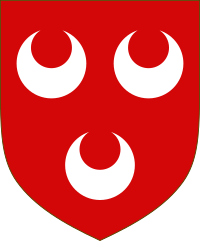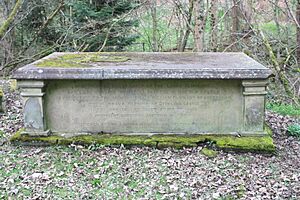William Oliphant, Lord of Aberdalgie facts for kids
Quick facts for kids
Sir William Oliphant
|
|
|---|---|
| Lord of Aberdalgie | |

Arms of Sir William Oliphant, Lord of Aberdalgie
|
|
| Died | 1329 |
| Noble family | Clan Oliphant |
| Spouse(s) | Elizabeth Bruce |
| Father | William Oliphant |
Sir William Oliphant (died 1329) was an important Scottish knight and leader. He was known as the Lord of Aberdalgie and Dupplin. He played a big part in the Wars of Scottish Independence, which were fights for Scotland's freedom.
Contents
Sir William Oliphant's Life
Early Battles and Imprisonment
Sir William Oliphant fought in the Battle of Dunbar in 1296. In this battle, the Scottish army, led by King John Balliol, lost to the English. After the battle, Sir William was captured. He was taken to Rochester Castle in England and held prisoner there.
He was later set free. This happened after he agreed to serve King Edward I of England in other countries. He then came back to Scotland. He became the second-in-command at Stirling Castle. His cousin, also named Sir William Oliphant, was the main commander.
The Siege of Stirling Castle
In 1304, Stirling Castle was attacked by King Edward I of England's army. This was a long attack called a siege. The soldiers defending the castle eventually had to give up. Sir William was captured again during this siege. He was sent to Wallingford Castle as a prisoner. His cousin, the castle commander, was sent to the Tower of London. Around this time, almost all of Scotland had promised loyalty to King Edward I. Only William Wallace continued to fight.
Release and Return to Scotland
Sir William Oliphant stayed in England until 1313. He was held by a powerful English lord named Hugh le Despenser. He was allowed to return to Scotland on October 21, 1313.
After returning, he became an important supporter of King Robert the Bruce. He was a witness to one of King Robert's official documents in 1314 or 1315.
The Declaration of Arbroath
On April 6, 1320, Sir William Oliphant was one of the people who signed the Declaration of Arbroath. This was a very important letter sent to the Pope. It declared that Scotland was an independent country and that Robert the Bruce was its rightful king. Sir William's official seal can still be seen on the document today.
Sir William's Burial Place
Sir William's tomb is located in Aberdalgie Churchyard. This is in Perthshire, Scotland. His grave is on the site where the first church once stood. The stone figure on his tomb is made from a special type of marble. This marble came from northern France or Flanders. His grave is in a quiet corner of the churchyard, near a small stream.
His Estates and Legacy
Sir William left his lands and properties to his son, Walter. These lands included Dupplin, Hedderwick, and Cranshaws. He inherited some of these from his family. Other lands like Aberdalgie, Turin, and Glensaugh came into the family through a marriage. He also received gifts of land from the King, such as Gasknes and Newtyle.
Sir William Oliphant's Family
Sir William Oliphant was married to Isabel Douglas. They had one son:
- Sir Walter Oliphant (Olifaunt) of Aberdalgie and Dupplin. He married Elizabeth, who was the youngest daughter of King Robert I (Bruce). Their family line continued, and a later descendant, Sir Laurence Oliphant of Aberdalgie, became the first Lord Oliphant in 1456.
See also


